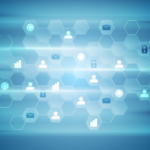Find out what today’s emerging workplace-related terms are — before leadership asks about them.
 Have you noticed, yet not quite understood, headlines about how employers might use blockchain in HR — or AI in HR — lately?
Have you noticed, yet not quite understood, headlines about how employers might use blockchain in HR — or AI in HR — lately?
Or overheard colleagues talking about blind hiring practices and wondered what they meant?
With so many new tech tools, business practices and other developments being introduced on a regular basis, trying to stay up to date with industry news can feel overwhelming.
If you’re not 100 percent sure what IoT is — or talent rediscovery, or any of the other terms on the list below, our guide can help introduce you to the HR buzzwords you’re likely to hear in the coming six to 12 months — if you haven’t already … including:
Talent rediscovery
Some organizations are using solutions that screen previous candidates to see if they might be a match for another position. Using a company’s candidate tracking system database, talent rediscovery software can help employers identify qualified candidates they may have missed when they first reviewed the person’s credentials.
Employee brand
Much like companies are finding they can benefit from having an employer brand, some workers are establishing personal workforce identities — employee brands. Seeing what skills workers want to highlight can help companies get a clearer idea of what training, project participation and other opportunities might meet both the employee’s and the company’s staffing, growth and other goals.
Blockchain in HR
 Best known for its connection to Bitcoin, blockchain technology basically serves as a ledger for various records, such as records of monetary transactions. In recent months, much has been written about ways to potentially use blockchain in HR, including serving as a repository for academic and professional achievements throughout an employee’s lifetime, which could make it easier for HR professionals to confirm credentials and learn about candidates. For a more detailed description of what blockchain is and could do for HR, view our blog post on ways using blockchain in HR could permanently change the way companies hire.
Best known for its connection to Bitcoin, blockchain technology basically serves as a ledger for various records, such as records of monetary transactions. In recent months, much has been written about ways to potentially use blockchain in HR, including serving as a repository for academic and professional achievements throughout an employee’s lifetime, which could make it easier for HR professionals to confirm credentials and learn about candidates. For a more detailed description of what blockchain is and could do for HR, view our blog post on ways using blockchain in HR could permanently change the way companies hire.
Blind hiring
In an effort to avoid conscious and unconscious bias, the stereotypes and generalizations that can influence a person’s perception of a job candidate, some organizations are utilizing blind hiring practices that mask information, such as a candidate’s name or dates associated with various items listed on the candidate’s resume, which could indicate the person’s age.
The Internet of Things (IoT in HR)
The Internet of Things is a term that loosely relates to tech devices’ ability to intelligently connect to the Internet through embedded sensors — such as wearable devices, for example, tracking the amount of steps a person takes throughout the day and conveying the information so it can be viewed online. Companies could incorporate IoT in HR in a number of ways; for instance, providing data on user behavior to identify patterns and help HR better address employee needs.
Gen Z
Born approximately from the mid-1990s to 2010, Generation Z employees are beginning to trickle into the workforce; and given the age group’s size, its impact could be profound. In 2015, 15- to 24-year-olds, a group that encompasses a number of Generation Z employees, accounted for one out of every six people worldwide, according to a United Nations report.
Unlike millennials, the generation that precedes it, Gen Z is said to be more like Generation X, favoring face-to-face interactions over technology, according to a study from 8×8, Inc.
HR analytics
Although the term analytics is sometimes used in tandem with big data, they’re actually somewhat different. Data refers to the information that’s gathered to be analyzed — a record of employee hours, for example, over a six-month period. HR analytics would refer to the insights gained from examining that information — such as methods to improve efficiency that are determined from reviewing employee hours and output.
AI in HR
Artificial intelligence refers to a system in which decisions are made and work is performed automatically and autonomously. Generally, AI involves taking some sort of action, instead of just assessing a situation. A robotic device, for example, may make decisions about how to move through a warehouse based on analysis of its layout, the device’s speed and current obstacles; or a tech solution may use analysis of an employee’s current amount of vacation time and schedule to send automated messages to the person suggesting when might be a good point to take the remaining time off.
A robotic device, for example, may make decisions about how to move through a warehouse based on analysis of its layout, the device’s speed and current obstacles; or a tech solution may use analysis of an employee’s current amount of vacation time and schedule to send automated messages to the person suggesting when might be a good point to take the remaining time off.
Green human resource management
With sustainability increasingly becoming a focus for businesses – company leaders, according to a McKinsey & Company survey of executives in various industries, more frequently view sustainability as a top CEO priority — HR is likely to be tasked with some involvement. With an enterprise-wide perspective, the department may be the ideal candidate to figure out ways to reduce paper needs and overall office energy use.
Curious to find out more about the above HR topics? Check out our blog posts on talent rediscovery, what employee branding could mean for your organization, the promising blind hiring practices that are helping companies eliminate conscious and unconscious bias, getting ready for Generation Z employees, transforming talent management with HR analytics, innovative ways companies are using AI in HR and 4 ways to green human resource management.